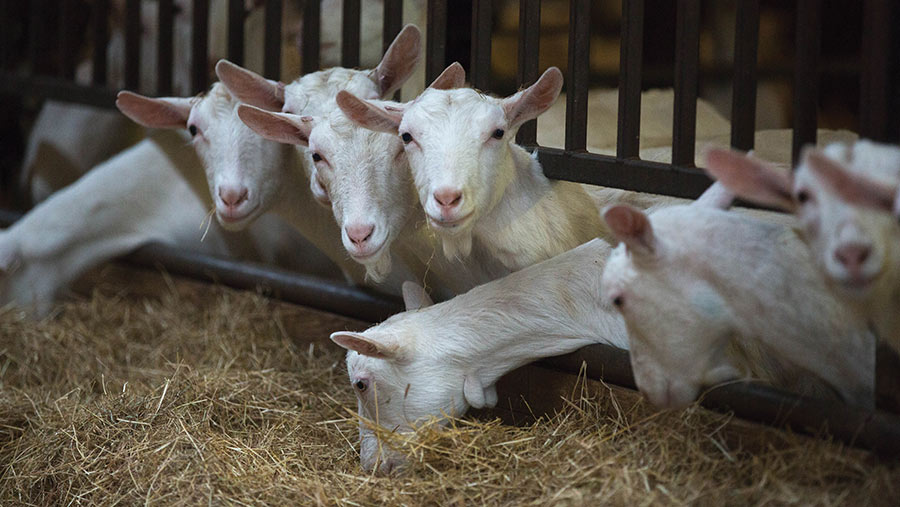5 ways to control parasites in dairy goats
 © Tim Scrivener
© Tim Scrivener Implementing and maintaining effective parasite control strategies is crucial for maximising productivity and ensuring the overall health and welfare of your dairy goat herd.
Parasites can significantly affect the wellbeing of your goats, leading to decreased milk production, weight loss and overall poor performance.
Concurrent disease such as lameness or mastitis, infectious diseases like caprine arthritis encephalitis (CAE), and essential mineral deficiencies will also reduce the ability of the immune system of the milking herd to respond appropriately to parasite burdens.
See more: Zero grazing helps dairy goat farmer to reduce concentrates
About the author

Jo Child is a vet and director at Dorset-based Friars Moor Vets. She graduated from the Royal Veterinary College in 2011 and specialises in dairy, cattle fertility, sheep lameness and parasitology.
Visit the Friars Moor Livestock Health website.
Which parasites are most common in goats?
Several parasites commonly affect dairy goats in the UK, including gastrointestinal worms (such as Haemonchus contortus), liver fluke (Fasciola hepatica), and external parasites such as mites, lice and ticks.
Understanding their life cycles and potential impact on your goats is vital for implementing an effective control plan.
Goats do not develop the same immunity or resilience to gastrointestinal strongyles that other small ruminants do.
This may be due in part to their evolution as browsers, not grazers and means high worm burdens can be found in goats of all ages and cause significant clinical disease.
The following parasite control strategies form part of a holistic herd health approach.
Regular faecal egg count to monitor levels of infestation
Regular monitoring of faecal egg counts (FEC) can provide valuable insights into the level of internal parasite infestation.
Working with your vet to establish a sampling schedule and target levels for treatment based on the FEC results will reduce the unnecessary use of anthelmintics.
Pasture management to limit parasite risk
Good pasture management plays a significant role in reducing parasite exposure. This may include:
- Rotational grazing and adequate rest periods between grazing periods, which can help break the parasite’s life cycle by limiting the goats’ exposure to infective larvae
- Providing goats with adequate browsing habitats to help reduce the contact they have with infective pastures. Many trees that goats like to browse, such as willow, also have natural anthelmintic properties.
Work with your vet and use a farm map to risk-assess your grazing for internal parasites at different times of the year. For example, grazing silage aftermath is less risky than permanent pasture that always carries youngstock.
When to use strategic anthelmintic treatment
While targeted anthelmintic treatment based on FEC results is the preferred approach, strategic treatment is sometimes necessary, especially during periods of high parasite risk.
This can be pertinent if goats are housed for part of the year. Housing can help to break the parasite cycle, and targeted treatments to coincide with housing can be very effective.
The number of products licensed for use in goats (particularly milking goats) is limited, which may affect when they can be used in lactation – if at all.
Always check adherence to withdrawal periods to ensure milk quality and consumer safety.
Dose rates for anthelmintics in goats need to be extrapolated from other small ruminant species and under veterinary guidance.
We tend to recommend increasing dose rates in goats compared with sheep.
Regular inspection and treatment for external parasites
External parasites such as lice, mites and ticks can cause discomfort and transmit diseases. Goats can be affected by several types of mites and mange, chorioptes, psoroptes and demodex are the most common.
Regularly inspect your goats visually for signs of infestation, which include itching, hair loss and skin irritation.
Your vet may need to carry out skin scrapes, plucks or tape strips to identify the parasite involved and select suitable treatments, such as pour-ons or injectables.
Proper housing and hygiene practices, including regular bedding changes, can also help prevent external parasite infestations.
Biosecurity measures to protect your herd
Implementing biosecurity measures is essential to prevent the introduction and spread of parasites.
By planning a comprehensive approach and working closely with your vet, you can reduce the impact of parasites on your herd. Key measures include:
- Quarantine new animals before introducing them to your herd to allow time for observation and potential treatment. Quarantine treatment should include two types of anthelmintic and suitable time to identify lameness or signs of clinical disease
- Clean and disinfect equipment and tools regularly, especially when moving between different goat groups or farms
- Restrict access to your farm by visitors and vehicles to minimise the risk of parasite introduction.
